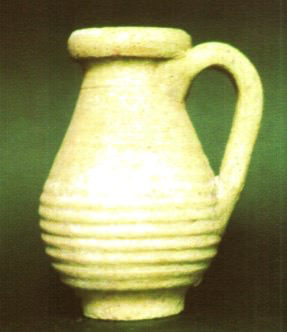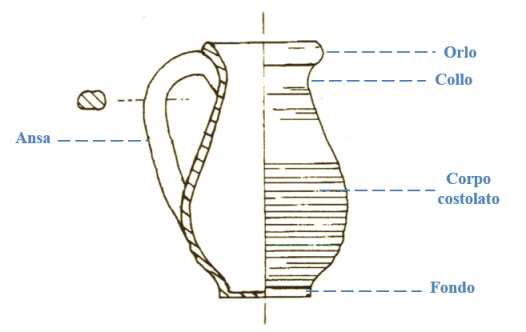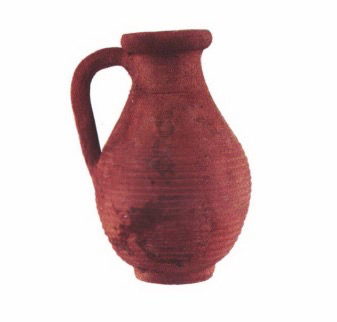Byzantine pitchers
From the sarcophagus tomb 112 in the Columbaris cemetery area, you have a whole specimen of a so-called "Byzantine" pitcher with its characteristic ribbed body (fig. 1).

The find is small in size, the handle resting on the neck, the thickened edge and truncated cone foot(fig. 2). Due to its size and to similar items found in tomb contexts - where it is usually found next to the person's skull - it has been related to not only the funerary aspect in general, but also with the refrigerium rite. In fact, it is found with tableware and common use pottery. According to some scholars, it should be interpreted as a tool used during baptism carried to the tomb as a symbol of one's conversion.

The presence of African terracotta sigillata found on top of the sarcophagus cover and in the layer around it made it possible to date the burial to the VI century A.D. Moreover, in the Cornus context, the Byzantine pitcher can be found in numerous fragments (fig. 3) found in the cemetery area.

This type of container spread all over the western Mediterranean basin in the period between the I and VII century A.D.: it is widely documented in both the peninsula and in North Africa, which were probably the main production areas. In Sardinia, this item type has been found in several sites; in particular in funerary contexts: the necropolis of Pill’e Matta at Quartucciu (fig. 4) and the necropolis of Barrua’e Basciu at Santadi.

Bibliografia
- P. BOSIO, Ceramica comune: olle, brocche, in A. M. GIUNTELLA (a cura di), Cornus I. 2. L'area cimiteriale orientale. I materiali = Mediterraneo tardoantico e medievale, 13. 2, Oristano 2000, pp. 283-287.
- Carbonia e il Sulcis = V. SANTONI (a cura di), Carbonia e il Sulcis. Archeologia e territorio, Oristano 1995, p. 471.
- Cornus I.2 = A. M. GIUNTELLA (a cura di), Cornus I. 2. L'area cimiteriale orientale. I materiali = Mediterraneo tardoantico e medievale, 13. 2, Oristano 2000, p. 11.
- A. M. GIUNTELLA, Note su alcuni aspetti della ritualità funeraria nell’alto medioevo. Consuetudini e innovazioni, in G. P. BROGIOLO, G. WATAGHIN (a cura di), Sepolture tra IV e VIII secolo. 7° Seminario sul tardo antico e l’alto medioevo in Italia centro settentrionale (Gardone Riviera, 24-26 ottobre 1996) = Documenti di archeologia, 6, Mantova 1998, pp. 66-67.
- A. M. GIUNTELLA, Cornus I.1. L'area cimiteriale orientale = Mediterraneo tardoantico e medievale. Scavi e ricerche, 13. 1, Oristano 1999, p. 168.
- D. LISSIA, Tipologie e corredi funerari, in D. LISSIA, D. ROVINA, Sepolture tardo romane e altomedievali nella Sardegna nord-occidentale e centrale, in AA. VV., Le sepolture in Sardegna dal IV al VII secolo. IV Convegno sull'archeologia tardoromana e medievale (Cuglieri 27-28 giugno 1987) = Mediterraneo tardoantico e medievale. Scavi e ricerche, 8, Oristano 1990, pp. 75-83.
- D. LISSIA, D. ROVINA, Sepolture tardo romane e altomedievali nella Sardegna nord-occidentale e centrale, in AA. VV., Le sepolture in Sardegna dal IV al VII secolo. IV Convegno sull'archeologia tardoromana e medievale (Cuglieri 27-28 giugno 1987) = Mediterraneo tardoantico e medievale. Scavi e ricerche, 8, Oristano 1990, pp. 75-100.
- D. SALVI, (a cura di), Luce sul tempo. La necropoli di Pill’ 'e Matta Quartucciu, Cagliari 2005, p. 109.
- P. PEDUTO, Villaggi fluviali nella Pianura Pestana del secolo VII. La chiesa e la necropoli di San Lorenzo di Altavilla Salentina, Altavilla Salentina 1984, pp. 57-63.
- D. ROVINA, E. GARAU, P. MAMELI 2008, Attività metallurgiche presso l’insediamento tardo antico di Santa Filitica a Sorso: dati preliminari archeologici e archeometrici, in J. GONZÁLES, P. RUGGERI, C. VISMARA, R. ZUCCA (a cura di), Le ricchezze dell’Africa. Risorse, produzioni, scambi. Atti del XVII Convegno di studio dell’Africa Romana (Siviglia, 14-17 dicembre 2006), Roma 2008, IV, pp. 2673-2696.
- D. SALVI, Conclusioni. Le novità derivate dallo scavo, in D. SALVI, (a cura di), Luce sul tempo. La necropoli di Pill’ 'e Matta Quartucciu, Cagliari 2005, pp. 187-202.
- A. SERENI, Osservazione sui reperti rinvenuti nell'area cimiteriale orientale di Cornus, in P. G. SPANU (a cura di), con la collaborazione di M. C. OPPO e A. BONINU, Insulae Christi. Il cristianesimo primitivo in Sardegna, Corsica e Baleari = Mediterraneo tardoantico e medievale. Scavi e ricerche 16, Oristano 2002, pp. 253-276.
- P. B. SERRA, Contesti tombali di età tardoromana e altomedievale da Santadi, in V. SANTONI (a cura di), Carbonia e il Sulcis. Archeologia e territorio, Oristano 1995, pp. 379-404.
- P. G. SPANU, La Sardegna bizantina tra VI e VII secolo, Oristano 1998, p. 215.

 VR
VR